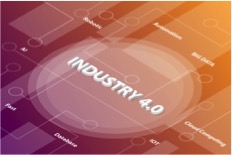Technology Trends and the Private-to-Public Equity (PPE) ™ Initiative
Overview
“To know your future, you must know your past” – a famous statement attributed to philosopher George Santayana, considered as one of the most important rules in life and society.
But, is this statement still valid today when we try to understand the impact of the new technological, industrial, and social transformations we are witnessing today?
Are the rules and approaches of the past still suitable to model the upcoming fourth industrial revolution, which see Artificial Intelligence (AI) as omnipresent, infused, and catalyzing force?
Technologists, economists, philosophers and journalists are debating around these questions with no clear answers yet.
 Some of them find comfort in observing similarities between today revolution and major changes happened in the world during the past centuries, e.g. first industrial revolution, the advent of the car with the displacement of the horses, the transformation of American agriculture in the twentieth century or the recent era of computer and internet. Despite all, humanity survived. Human creativity and endurance, and the robustness of capitalist market provided continuity, the creation of new skills and jobs, and the wealth distribution.
Some of them find comfort in observing similarities between today revolution and major changes happened in the world during the past centuries, e.g. first industrial revolution, the advent of the car with the displacement of the horses, the transformation of American agriculture in the twentieth century or the recent era of computer and internet. Despite all, humanity survived. Human creativity and endurance, and the robustness of capitalist market provided continuity, the creation of new skills and jobs, and the wealth distribution.
Others, instead, envision catastrophic future and looming days, in which a useless unemployed man will be dominated and exploited by a supreme Artificial Being.
The truth however, might be in the middle, as usual. Both extreme scenarios deserve some reflection and analysis, which should include, as sometimes neglected, political and demographic considerations. Human progress and technology always have the potential to create a better world and more distributed wealth. However, paraphrasing the MIT economist David Autor[1]weather we use well the wealth does not depend on the technology itself, but on the institutions and policies we create.
Leaving these considerations behind, if we look carefully at the most outstanding difference between today’s global markets with the one of even a decade ago, it appears evident that technology is a fundamental aspect for every industry and organization.
Towards a Technology-Centric Economy
The question business leaders now face is how to employ those technologies and capitalize on them to insure the long-term health and prosperity of the business. The business landscape is littered with businesses, some truly world famous, legacy institutions, that have not successfully passed through this gauntlet of technological upheaval. We all know the stories: retail businesses devastated by on-line sellers, video streaming fueling a “cable cutting” epidemic, electric vehicles replacing the venerable internal combustion engine and the list goes on.
 Beyond the business impact, we are seeing very direct human impacts as voice response systems replace human operators, automated terminals replace bank tellers and retail checkout clerks and robots replace factory workers. Further, the pace of change continues to accelerate, especially in those areas where the rapidly growing capabilities of artificial intelligence (AI) are beginning to emerge and challenge the “knowledge worker” that was once thought to be immune from technological displacement.
Beyond the business impact, we are seeing very direct human impacts as voice response systems replace human operators, automated terminals replace bank tellers and retail checkout clerks and robots replace factory workers. Further, the pace of change continues to accelerate, especially in those areas where the rapidly growing capabilities of artificial intelligence (AI) are beginning to emerge and challenge the “knowledge worker” that was once thought to be immune from technological displacement.
On the positive side, these same technological forces, while threatening the “old order”, have created vast opportunities for new enterprises, enabled greatly enhanced product and service capabilities and brought new opportunities to many. The situation is a kaleidoscope of crisscrossing themes and we are all searching for Santayana-like wisdom to help us navigate the broadening technological, industrial, economic and social transformations we are witnessing: “To know your future, you must know your past”.
It is instructive to review some specific industry examples to gain insight into what could be in our future and how this could impact existing businesses.
- Manufacturing corporations and warehouses have completely transformed and automated the operation of their facilities from production, inventory management and final shipment processes. This was achieved by exploiting technological advances in AI, robotics, 3D Printing and the Internet of Things (IoT). Amazon, as an example, thanks to the acquisition of Kiva Systems, deployed more than 100,000 robots across its warehouses around the world two years ago [2].
- Retailers, healthcare services, airlines, insurances companies and financial institutions that have transformed themselves into highly advanced technological organizations are becoming more common [3,4,5]. Digital marketing, predictive analytics, advanced fraud detection, personalized purchase recommendations, smart “bots”, sentiment analysis and virtual assistants are all tools being used by innovative organizations to create new and higher quality services, increase market share, improve customer retention and accelerate revenue growth.

- Agricultural firms are relying ever more on a combination of IoT, highly accurate Global Navigation Satellite System (GNSS) technologies, satellite imagery, “big data” and AI to optimize operations, predict crop yields, detect anomalies and manage their complex infrastructures [6,7].
Stealing a line from Aldus Huxley, it truly is “a brave new world”, but one that need not be as dystopian as he suggested.
Responding to the Impact of Technology
As a business leader, what is one to do? Essentially, businesses have four basic strategies available to deal with this onslaught of technical change and the challenges therein:
- Invest heavily in developing new technologies to enhance either the capabilities of the business and/or to create whole new lines of business.
- Acquire new technology and/or businesses via strategic M&A activities.
- Search for a stronger partner to acquire the business and integrate it into the partner’s broader business operations.
- Accept that the business is “over” and do what can be done to maximize the terminal value of the business.
All of these options are fraught with risks and challenges, but the most dangerous path is to not accept the reality of the situation and do nothing.
The Role of Financial Capital in a Technology-Centric Economy
While the “force majeure” behind the current technological tidal wave is technology, any business attempting to implement the first or second strategy noted above, or some combination of the two, will quickly find itself in need of financial capital to fund the effort. The question then before leadership team is what path to take to acquire the needed capital investment beyond what the ongoing operations of the business can generate. Technology may be the “water” in the pipe of innovation and change, but it is access to capital that is the “control valve” and the long-standing principles of sound business financing are always in play, regardless of the current fads of “unicorns”, crypto currencies, etc.
 This brings us to the question of what sources of capital are available to the business and how to best fit them into the financial structure of the business. The options available are essentially five:
This brings us to the question of what sources of capital are available to the business and how to best fit them into the financial structure of the business. The options available are essentially five:
- Raising debt financing based on the business’s EBITDA.
- Selling off hard assets (i.e. real estate) and leasing them back if still needed.
- Selling off less interesting or less fundamental parts of the business.
- Obtaining equity financing through private channels.
- Obtaining equity financing through access to the public capital markets.
Each of these financing methods has its unique attributes to be considered, as the net amount of financing available, the long and short impacts on the business, the potential loss of flexibility or control of the business due to debt covenants or private investor demands, the cost of the financing, the ability to continually access the capital pool as the business grows, etc. This discussion focuses on the last option noted, “equity financing through access to the public capital markets”, i.e. going public, and a particular method of doing so through a Special Purpose Acquisition Company (SPAC) transaction, equity financing.
SPAC Financing Basics
For those who are not familiar with the SPAC concept, it can basically be described as follows:
- The SPAC entity, sometimes referred to as a “blank check” company, is first formed by an investor group of experienced and qualified investors and business professionals.
- The SPAC then undergoes the typical initial public offering (IPO) process, whereby the company is listed on a major US exchange, receives a “ticker” on that exchange, raises capital and starts market trading. The entire process, exactly as in the standard IPO process, is tightly controlled and regulated by the SEC rules.
- Immediately after successful completion of the IPO process, the SPAC entity, which has a limited time duration before expiration and dissolving itself (typically 18-24 months), launches a search process to identify an appropriate target company, negotiates a definitive agreement to merge with that company using the “reverse merger” mechanism and implements the merger, typically within 6-9 months after the execution of the definitive agreement.
- The result is that the target company becomes listed on a major US stock exchange under a new “ticker” symbol and has full access to the public capital market.
- Additionally, the company typically enjoys an infusion of cash at the closing of the combination.
Overall, this process provides the target company a faster and lower risk path to becoming a publicly listed entity with less disruptions to the on-going operations of the company and its strategic growth plans. In particular, as compared to a traditional IPO process, the SPAC process significantly reduces the management time and attention required to achieve public company status. In many ways, a SPAC process can be characterized as “an IPO in box”.
Because of its effectiveness in bringing companies public, especially for fast growing, late-stage private companies that are resource limited by the nature and growth stage of the company, the SPAC process has gained significant interest from both the financial and enterprise communities, as evidenced by the significant growth in the number of SPAC IPO offerings in recent years and their increasing portion of IPO activities. There has been an upward trend in SPAC IPOs since 2011. In 2018, SPACs accounted for 24% of all U.S. IPO transactions and 21% of IPO dollar value. [8]
GigCapital, comprising entrepreneurs and executives with longstanding industry and technology experience, who have grown companies from start-up to large publicly traded corporations, believes in fundamentals. We think that continued innovation, healthy balance sheet, and a bit of Santayana’s philosophy is the right recipe to build competitive and successful Unicorns. We established a unique approach that we call Private to Public Equity (PPETM) [9,10], which aims to not only facilitate a successful transition of a late stage private company to a publicly listed company, but also set it on the growth path to a global leader. We support our partners with broad range of financial, operation, technology and M&A expertise needed to grow as publicly traded company as entering into the upcoming fourth industrial revolution. Embracing technology and its related tools is a strategic need for any company, in any industry, that aims to becoming a global leader in this new technology-centric economy and GigCapital is the right partner in such an exciting journey.
References
[1] “Will Automation take away all your jobs?”, David Autor, TED Talk, March 29, 2017
[2] “As Amazon Pushes Forward With Robots, Workers Find New Roles”, Nick Wingfield, The New York Times, Sept. 2017
[3] “Walmart Moves From Traditional Retailer To High-Tech Innovator”, Shep Hyken, Forbes, Oct. 2017
[4] “How America’s Top 4 Insurance Companies are using Machine Learning”, Kumba Sennaar, Emerj, June, 2019
[5] “KLM’s AI service bot added to Google Home and Google Assistant”, Future travel experience, Dec. 2017
[6] “How AI Is Transforming Agriculture”, Kathleen Walch, Forbes, July, 2019
[7] “Intel-Powered AI Helps Optimize Crops Yield”, Medium, Sep 16, 2019
[8] “The Special Purpose Acquisition Company (SPAC) or Private to Public Equity (PPE)™ Initiative”, GigCapital, 2019
[9] “Comparing a Private-to-Public Equity (PPE)™ (Special Purpose Acquisition Company – SPAC) Transaction to a Private Equity (PE) Transaction”, GigCapital, 2019
[10] “Private-to-Public Equity (PPE)™ Business Combination Initiative – An Attractive Alternative to Selling the Company”, GigCapital, 2019